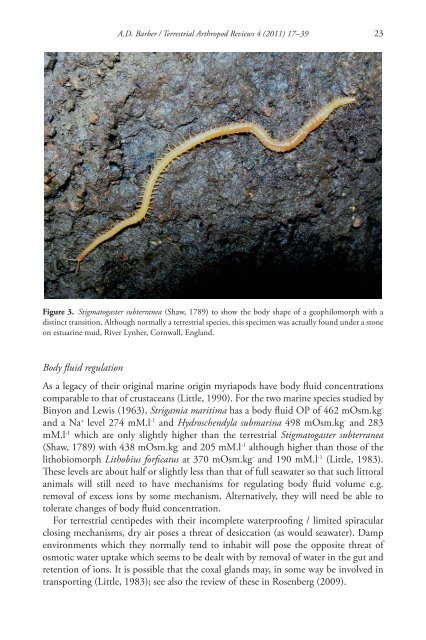Geophilomorph centipedes and the littoral habitat - Books and ...
Geophilomorph centipedes and the littoral habitat - Books and ...
Geophilomorph centipedes and the littoral habitat - Books and ...
Create successful ePaper yourself
Turn your PDF publications into a flip-book with our unique Google optimized e-Paper software.
Body fl uid regulation<br />
A.D. Barber / Terrestrial Arthropod Reviews 4 (2011) 17–39 23<br />
Figure 3. Stigmatogaster subterranea (Shaw, 1789) to show <strong>the</strong> body shape of a geophilomorph with a<br />
distinct transition. Although normally a terrestrial species, this specimen was actually found under a stone<br />
on estuarine mud, River Lynher, Cornwall, Engl<strong>and</strong>.<br />
As a legacy of <strong>the</strong>ir original marine origin myriapods have body fl uid concentrations<br />
comparable to that of crustaceans (Little, 1990 ). For <strong>the</strong> two marine species studied by<br />
Binyon <strong>and</strong> Lewis ( 1963 ), Strigamia maritima has a body fl uid OP of 462 mOsm.kg -<br />
<strong>and</strong> a Na + level 274 mM.l -1 <strong>and</strong> Hydroschendyla submarina 498 mOsm.kg - <strong>and</strong> 283<br />
mM.l -1 which are only slightly higher than <strong>the</strong> terrestrial Stigmatogaster subterranea<br />
(Shaw, 1789) with 438 mOsm.kg - <strong>and</strong> 205 mM.l -1 although higher than those of <strong>the</strong><br />
lithobiomorph Lithobius forfi catus at 370 mOsm.kg - <strong>and</strong> 190 mM.l -1 (Little, 1983 ).<br />
Th ese levels are about half or slightly less than that of full seawater so that such <strong>littoral</strong><br />
animals will still need to have mechanisms for regulating body fl uid volume e.g.<br />
removal of excess ions by some mechanism. Alternatively, <strong>the</strong>y will need be able to<br />
tolerate changes of body fl uid concentration.<br />
For terrestrial <strong>centipedes</strong> with <strong>the</strong>ir incomplete waterproofi ng / limited spiracular<br />
closing mechanisms, dry air poses a threat of desiccation (as would seawater). Damp<br />
environments which <strong>the</strong>y normally tend to inhabit will pose <strong>the</strong> opposite threat of<br />
osmotic water uptake which seems to be dealt with by removal of water in <strong>the</strong> gut <strong>and</strong><br />
retention of ions. It is possible that <strong>the</strong> coxal gl<strong>and</strong>s may, in some way be involved in<br />
transporting (Little, 1983 ); see also <strong>the</strong> review of <strong>the</strong>se in Rosenberg ( 2009 ).









![Am HaSefer [Volk des Buches] - Books and Journals](https://img.yumpu.com/20648352/1/174x260/am-hasefer-volk-des-buches-books-and-journals.jpg?quality=85)







